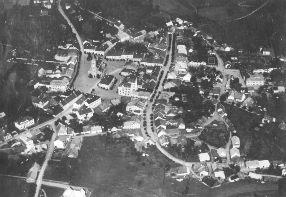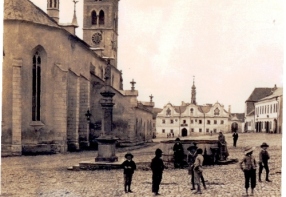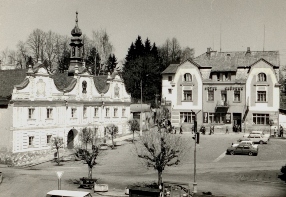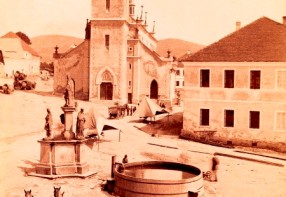HISTORY OF THE TOWN
The history of Kašperské Hory is closely connected with the discovery of gold. The most likely, already the Celts new well the gold-bearing region in the surroundings of the Otava, the Losenice and the Zlatý Stream. They nevertheless preferred to wash gold from sandy drifts instead of mining it.
The current settlement is usually considered to origin from the turn of the 13th and 14th century. The oldest written record about the settlement can be found in the mortgage deed of the King Jan Lucemburský (John of Bohemia) from 10th July 1338, referring to Kašperské Hory as one of the most important locations of gold mining in Bohemia.
The community came to the supreme prosperity in course of the 14th century, as the local gold-bearing district provided the sovereigns with considerable quantity of gold, thus strengthening heir power. In 1345, under the ruling of Jan Lucemburský, Kašperské Hory was promoted to mining town, acquired the town seal and coat of arms. In the same period, the citizens of Kašperské Hory received privilege from the King Jan exempting them from duties and taxes as an expression of thanks for their military assistance in the campaign against the town of Landshut in Silesia, allegedly participated by 600 local miners.
The King Charles IV also paid special attention to the town, by not only the construction of the significant guard-castle of Kašperk in 1356-1361 but also by establishment of the important trade route consisting of Kašperské Hory branch of the Golden Path going from Passau to Kašperské Hory. Besides that, under the direction of the Czech King and the Roman Emperor, the draft country code of laws called Majesta Carolina was prepared, expressing among others the first endeavour of the Czech forestry economics.
Contemporary Kašperské Hory and nearby Rejštejn originally formed one municipality under the name of Reichenstein, later Bergreichenstein or Bohatý kámen (Rich Stone). Strong connection between the two settlements the most probably ended up sometime in the late 14th century already. In 1584, the Emperor Rudolf II upgraded Kašperské Hory to royal mining town and in the same year the legal linkage of Kašperské Hory and Rejštejn ceased to exist. After this legal separation both towns preserved the status of royal mining towns.
Since the end of the 16th century gold mining has nevertheless been declining. In the second half of the 18th century mining continued in only several drifts. Ultimate termination of all mining works occurred in 1777. Declining mining was gradually substituted by development of glass-making, forestry, woodworking, trade and farming.
In the 19th century, the locality became a seat of the district court and, as part of the wood-processing industry, a modern factory manufacturing matches was founded. In 1930 there were 2289 citizens living in the town, of that 186 Czechs. Pursuant to the Munich Agreement, Kašperské Hory were attached to the Great German Empire in October 1938. It returned to the Czech hands after liberation by the American Army in early May 1945. Displacement of German citizens was taking place till 1946. They were later replaced by people from the whole Czech Republic.
Today, Kašperské Hory owe its prosperity mainly to the development of tourism and forestry. The municipality currently owns the third largest area of forests amongst all the other Czech towns, right behind the towns of Brno and Písek.
Kašperské Hory also formed a background scenery to novels and stories written by a significant author from the Šumava region - Karel Klostermann (1848–1923). His father worked here as a doctor and also served in position of the town mayor for several years.
The current settlement is usually considered to origin from the turn of the 13th and 14th century. The oldest written record about the settlement can be found in the mortgage deed of the King Jan Lucemburský (John of Bohemia) from 10th July 1338, referring to Kašperské Hory as one of the most important locations of gold mining in Bohemia.
The community came to the supreme prosperity in course of the 14th century, as the local gold-bearing district provided the sovereigns with considerable quantity of gold, thus strengthening heir power. In 1345, under the ruling of Jan Lucemburský, Kašperské Hory was promoted to mining town, acquired the town seal and coat of arms. In the same period, the citizens of Kašperské Hory received privilege from the King Jan exempting them from duties and taxes as an expression of thanks for their military assistance in the campaign against the town of Landshut in Silesia, allegedly participated by 600 local miners.
The King Charles IV also paid special attention to the town, by not only the construction of the significant guard-castle of Kašperk in 1356-1361 but also by establishment of the important trade route consisting of Kašperské Hory branch of the Golden Path going from Passau to Kašperské Hory. Besides that, under the direction of the Czech King and the Roman Emperor, the draft country code of laws called Majesta Carolina was prepared, expressing among others the first endeavour of the Czech forestry economics.
Contemporary Kašperské Hory and nearby Rejštejn originally formed one municipality under the name of Reichenstein, later Bergreichenstein or Bohatý kámen (Rich Stone). Strong connection between the two settlements the most probably ended up sometime in the late 14th century already. In 1584, the Emperor Rudolf II upgraded Kašperské Hory to royal mining town and in the same year the legal linkage of Kašperské Hory and Rejštejn ceased to exist. After this legal separation both towns preserved the status of royal mining towns.
Since the end of the 16th century gold mining has nevertheless been declining. In the second half of the 18th century mining continued in only several drifts. Ultimate termination of all mining works occurred in 1777. Declining mining was gradually substituted by development of glass-making, forestry, woodworking, trade and farming.
In the 19th century, the locality became a seat of the district court and, as part of the wood-processing industry, a modern factory manufacturing matches was founded. In 1930 there were 2289 citizens living in the town, of that 186 Czechs. Pursuant to the Munich Agreement, Kašperské Hory were attached to the Great German Empire in October 1938. It returned to the Czech hands after liberation by the American Army in early May 1945. Displacement of German citizens was taking place till 1946. They were later replaced by people from the whole Czech Republic.
Today, Kašperské Hory owe its prosperity mainly to the development of tourism and forestry. The municipality currently owns the third largest area of forests amongst all the other Czech towns, right behind the towns of Brno and Písek.
Kašperské Hory also formed a background scenery to novels and stories written by a significant author from the Šumava region - Karel Klostermann (1848–1923). His father worked here as a doctor and also served in position of the town mayor for several years.




